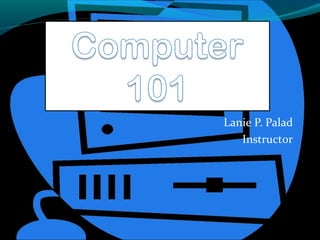
Lecture 3
- 2. Word Processing is a term coined to emphasize the manipulation of certain types of data- characters combined to form words, sentences, paragraphs, memos, letter and reports. 1964- the beginning of widespread use of word processing. Word processing system comprises equipment, procedure and people whereby thoughts and ideas are expressed and distributed in hardcopy or softcopy.
- 3. Capabilities of Word Processing 1. Automatic Functions 2. Storage Functions 3. Display Functions 4. Communication Functions 5. Sophisticated Functions 6. Programming Functions
- 4. Programming Cycle 1. Defining the problem 2. Planning a solution to the problem 3. Coding the solution 4. Checking out the program by debugging and testing 5. Documentation
- 5. Documentation 1. Complete statement of the problem 2. Description of the program logic and copies of the flow charts 3. Final source listing 4. List and description of error tests along with the disposition of these errors 5. Operating instructions, including program and data structures and test data used 6. Input and output specifications 7. Schedules to be maintained
- 6. Programming Languages Computers accomplish their task only when properly instructed by programs. In writing program instructions, the programmer uses a languages which can be understood by computer. Categories of Programming Languages 1. Machine Languages – Every computer has its own machine language and this only language it understands. With earlier computers, were all written in machine language. Coding a program in machine language is not an easy task; writing instructions in a binary notation.
- 7. 2. Symbolic Languages – Because of the difficulties involved in writing and testing a machine-language program, several symbolic programming languages have been developed. Symbolic languages permit the programmer to use convenient symbols or mnemonics when writing a program. 3. High -Level Language-High – level language statements closely resemble English language statements. The mathematical symbols are for the most part, the symbols of traditional mathematics.
- 8. Advantage of high – level language 1. It is easily learned and understood being almost English. 2. Lesser time is required to write programs. 3. They are standardized and can be accepted by any computer which has a compiler for a particular language 4. They provide better documentation and are much easier to maintain 5. Availability of diagnostic error detection allows the compiler to check program statements for syntactical errors
- 9. Number System The number system that we now use has provided mathematician, engineers and scientists with a great advantage over those of previous civilization. The earliest numerals which have been found consist of either vertical or horizontal marks. The decimal number 1 is an example of this sort of symbol. We have always been accustomed to working primarily with the decimal system. It is important to note that there are many other system for numerical calculation and some are far better suited to the capabilities of digital computers.
- 10. Unitary System In counting, the simplest system, the simplest system is not the decimal system, but a one-to-one comparison between the objects to be counted and the count or tally, A long series of tallying marks is simplified by breaking up the long series of tallying marks into group of five, by making a diagonal stroke through each set of mark, marks as ______.
- 11. Decimal System The decimal system for counting has been so widely used from time immemorial. It is based upon the ten fingers of man. This system is nothing more than a code where each distinct quantity is assigned a symbol. In the decimal system the following digits are used: 0,1,2,3,4,5,6,7,8 and 9. These symbols are called the Arabic numerals.
- 12. Scientific and Engineering Notation In Scientific and Engineering Notation , we frequently encounter very large or very small numbers. For example the distance of Mars from the sun is 226, 400, 000 kms the speed of light is 300 000 000 meters per second, the distance in terms of meter for one light year is approximately 9 240 000 000 000 000 meters. Scientific notation provide convenient scheme for representation of such quality.
- 13. Rounding off values Rounding of values is the process of dropping or eliminating one or more of the final digits on the right so that the value contains only significant figures required for further computation or for reporting in the final result. Truncating The process of deleting a certain digit rather than rounding off the number is called truncating or chopping.
- 14. Data Representation in Computers In computer, data is recorded as electronic signals or indications. The presence or absence of these signals in specific circuitry represents data in the computer just as the presence or absence of punched holes represent data on a punched card.
- 15. The binary method of notation can be used to describe the setting of binary components. The system is the positional numeration system to the base 2. Binary notation uses only two symbols 0 and 1. Division 139/2 69/2 34/2 17/2 8/2 4/2 2/2 Quotient 69 34 17 8 4 2 1 Remainder 1 1 0 1 0 0 0
- 16. Binary – Decimal Conversion 101 = 1x2² + 0x2¹ 1x2º = 4 + 0 + 1 = 5 1100= 1x2³ + 1 x2² + 0x2¹ + 0x2º = 8 + 4 + 0 + 0 = 12